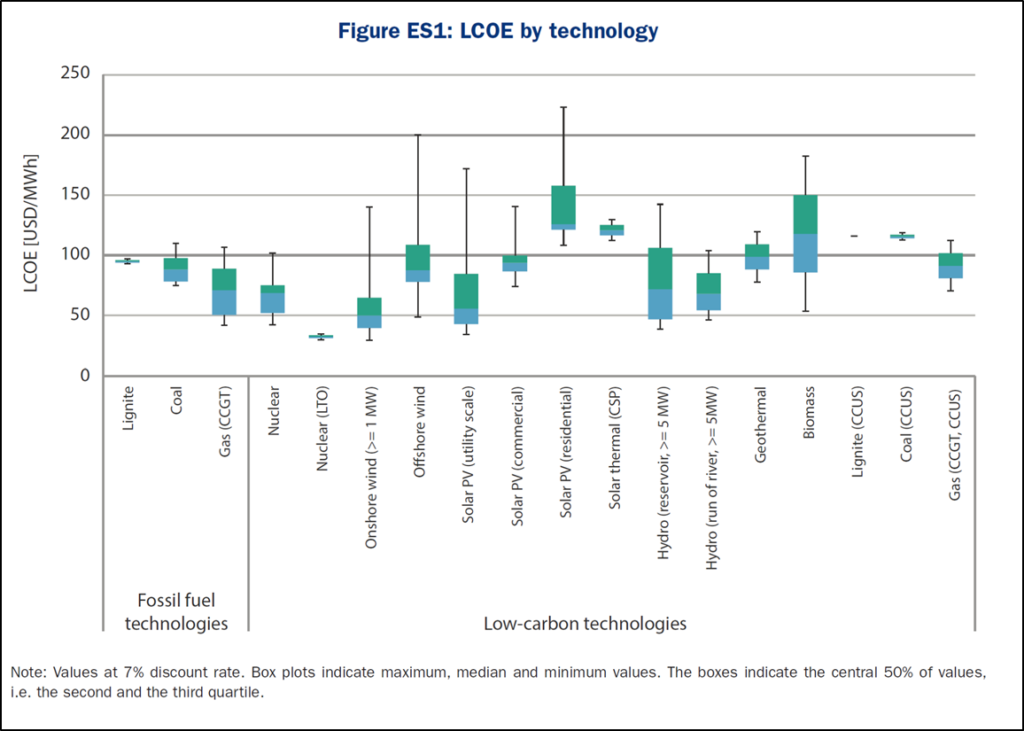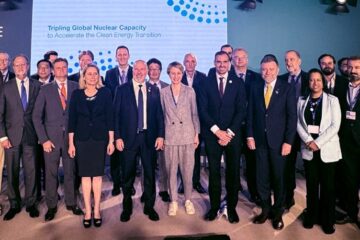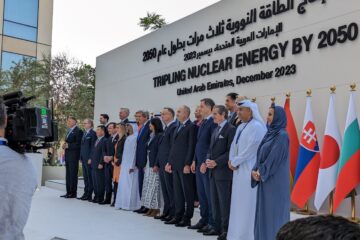Yes – Nuclear power is an economically competitive low carbon energy source
When it comes to the economics of electricity, there is no report more important than Projected Cost of Electricity, issued every 5 years by the International Energy Agency (IEA) and the OECD Nuclear Energy Agency (NEA). This report (now in its 9th edition) collects electricity costs of various technologies from a range of countries and reports on the competitiveness of each. The 2020 version of this report was issued in December and its conclusion is clear – nuclear power is the dispatchable (meaning always available) low-carbon technology with the lowest expected costs.

This is in stark contrast to what we often hear – that even though nuclear power may well be a low carbon solution, its costs are much too high to consider. Recent projects that have not gone well, primarily in the west due to a long absence from nuclear construction coupled with the challenges of building first of a kind (FOAK) designs are the evidence to support this argument. The successful economic deployment of nuclear in countries like China, Korea and Russia are ignored. We even have a good example that new countries can successfully build nuclear plants with the start up of the Barrakah nuclear power plant in the UAE.
This report sees through this bias. This is not a nuclear report. It is about electricity and its costs. The conclusions are based on the results of the analysis, not on any preconceived biases. It concludes that all low carbon options have improved their costs since the 2015 version.

One change since the 2015 version of this report is the inclusion of nuclear life extension or Long-Term Operation (LTO) in addition to the traditional consideration of the economics of nuclear new build. The results show that LTO provides the lowest cost electricity of all technologies considered. This makes for a very simple message – for the best low carbon, low-cost option – invest in keeping the current nuclear fleet operating.
Given the changing generating mix from traditional fossil fuelled plants to more and more variable renewables; there is an acknowledgement that to truly understand their economics the costs to the system of incorporating these variable resources must be considered. A model, called the Value Adjusted Levelized Cost of Electricity (VALCOE) has been developed but adds considerable complexity given, as would be expected, results are very sensitive to the actual system being analysed. This approach continues to be a work in progress. We should expect a more fulsome analysis in the next edition.
When it comes to nuclear, this report notes that countries willing to pursue the nuclear option have three main technology solutions to reduce cost at the system and plant level (interestingly consistent with our previous series on Saving the Planet):
- LTO or investing to keep the current fleet operating into the future.
- Building existing Generation III reactors. These designs have now passed their FOAK demonstrations and are ready to demonstrate improved economics going forward; and
- New designs being developed such as Small Modular Reactors (SMRs). These designs are poised to extend the value proposition of nuclear power.
The IEA/NEA, in its updated Projected Cost of Electricity report, has assessed the costs of the many low carbon options to meet electricity needs going forward. Based on this analysis, nuclear power is well positioned to continue and expand its role in providing reliable, economic, low carbon electricity to the world.





2 Comments
Keith Bradley · January 25, 2021 at 5:45 pm
Good summary Milt. If we look at the Canadian context, the comparisons are even more stark. Consider the LUEC that will result from Muskrat Falls or Conawapa, not to mention Site C if it ever gets built.
François Morin · January 28, 2021 at 7:33 am
Yes very clear! But still shouldn’t we evaluate another cost, which first include system cost. It is not the case in IEA evaluation which stipulates: “Costs are calculated at the plant level (busbar), and therefore do not include transmission and distribution costs”. If you consider only the copper needed for connection, it takes 5.5 tons of Copper/MWe Wind or Solar, that you need to add to existing grid. But beyond this ‘system’ costs we should even compare only full costs for integrated supply – all along the day, the year etc.- In fact only the costs of various realistic electricity mixes give true valuable comparison. Let me explain: 20% of Wind penetration for instance, should be evaluated together with the 80% back-up, gas/coal/oil etc.
So a mix 20% Wind onshore+10%Solar PV+ 40%gas+15%hydro+10%biomass+5%coal=80USD/MWh
while a mix of 50%nuclear+15%hydro+10%biomass+15%gas+10%coal= 65USD/MWh.
There is no free choice of sources. They are limited and constrained in quantity, depending on countries, environmental conditions etc.
Comments are closed.